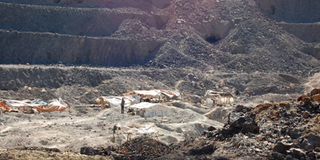DRC government pushes back against US child labour assessment


The Democratic Republic of Congo (DRC) has protested the US labelling of child labour in mines, with Kinshasa saying the assessment does not take into account the steps taken to improve on the sector’s governance.
The reactions this week followed a US Department of Labour’s report that said cobalt ore from the DRC is on the 2024 list of goods produced by child or forced labour.
In an information note addressed to the DRC government and dated September 24, the US states that this mineral presents a high risk because it comes from artisanal mines. It also established a link between forced labour and artisanal and industrial mining.
But the Congolese government argued the report “deliberately ignores local realities and damages the international reputation of the Congolese mining sector.” In a press release, the Congolese government denounced the inclusion of Congo’s cobalt on the blacklist.
“It tends to call into question the effectiveness of international compliance control and supply chain due diligence mechanisms recognised in terms of human rights, labour and safety, to which manufacturers are rigorously subjected by independent international structures working directly with Western multinationals (European and American) to take account of end users,” the statement said.
The DRC is the world's largest producer of cobalt, with about 70 percent of the world's deposits of the mineral essential for the production of batteries for electric cars.
The list by the Department of Labour could now be referenced by civil society seeking to highlight labour rights violations in global value chains, and by companies working to prevent and mitigate such violations.
"The inclusion of DRC cobalt in the list of products subject to forced labour was motivated by an Ilab-funded study in 2023, which revealed that workers in industrial and artisanal mines were subject to forced labour. The study highlighted indicators of forced labour, including excessive overtime, hazardous work, dismissal, unpaid wages, fines, debt bondage and other negative human rights consequences. The report also makes a passing reference to the fact that the cobalt industry in the DRC is dominated by large Chinese-owned mines, "the report states.
The Congolese government says it has implemented a number of reforms to improve regulation of the sector, including the creation of the General Inspectorate of Mines, the revitalisation of the Authority for the Regulation of Subcontracting in the Private Sector (ARSP), the operationalisation of the Authority for the Regulation and Control of Strategic Mineral Substances Markets (Arecoms) and the promotion of transparency in supply chains and membership of international initiatives such as the Extractive Industries Transparency Initiative (Eiti).
“Child labour and forced labour in informal, and therefore illegal, artisanal mining, Entreprise Générale du Cobalt, created in 2019, is working to make artisanal mining viable through rigorously ethical, responsible and transparent measures in cobalt mining in accordance with Congolese laws and international standards in the field.”
Générale du Cobalt, whose purpose is to oversee artisanal cobalt production, only became operational in 2023. It has faced challenges of mastering the full complexity of artisanal cobalt production. Éric Kalala, its managing director, admitted that he did not know the exact number of artisanal cobalt workers.
The Service d'assistance et d'encadrement des mines artisanale et à petite échelle (Saemape), which is supposed to supervise artisanal and small-scale mining in the DRC, does not know the number of artisanal players either.
In the country, artisanal mining is a source of great chaos, even though it is legal. Sometimes operators struggle to draw a line between apprenticeship and child labour, given that most mining operations are family-run businesses.
President Félix Tshisekedi and his officials have argued that that the war in the DRC is fuelled by armed groups and multinational companies with the aim of plundering its mineral resources.
This may explain the existence of armed groups in the mining areas. Rebels in the east have consolidated their control over the Rubaya coltan mining region, for instance, imposing a tax on production estimated to be $300,000 in monthly revenue, according to Bintou Keita, the UN Secretary General's Representative in the DRC.
Trade in minerals from the Rubaya region accounts for more than 15 percent of the world's supply of tantalum, which is produced by artisanal miners.
Several UN reports show that artisanal mining by armed groups is at the source of massacres in the Congo. Donat Kambola, a civil society activist in Kolwezi, the cobalt heartland of the DRC, told The EastAfrican that artisanal mining is “a reign of chaos.”
“The picture is unfortunately bleak, despite what we are told, particularly about the increase in revenues in the artisanal mining sector in the provinces. But these human rights issues, questions of compensation, of transparency, remain. That's why I believe that no matter how the law is reformed, the evidence on the ground is to the contrary. The sector has not improved. The eternal problem is the failure to create artisanal zones. As a result, artisanal miners are still breaking into industrial sites. The other problem is identifying artisanal miners,” Kambola argued.
In the DRC, mining generates substantial financial resources, which influential political players lease out to workers, sometimes in contravention of legal procedures. Miners and politicians are often linked or related, he said.
“All the Chinese or Lebanese operators who are involved in the mining sector have their 'umbrellas' (protectors), and on the ground there is chaos,” he said.








0 Comments